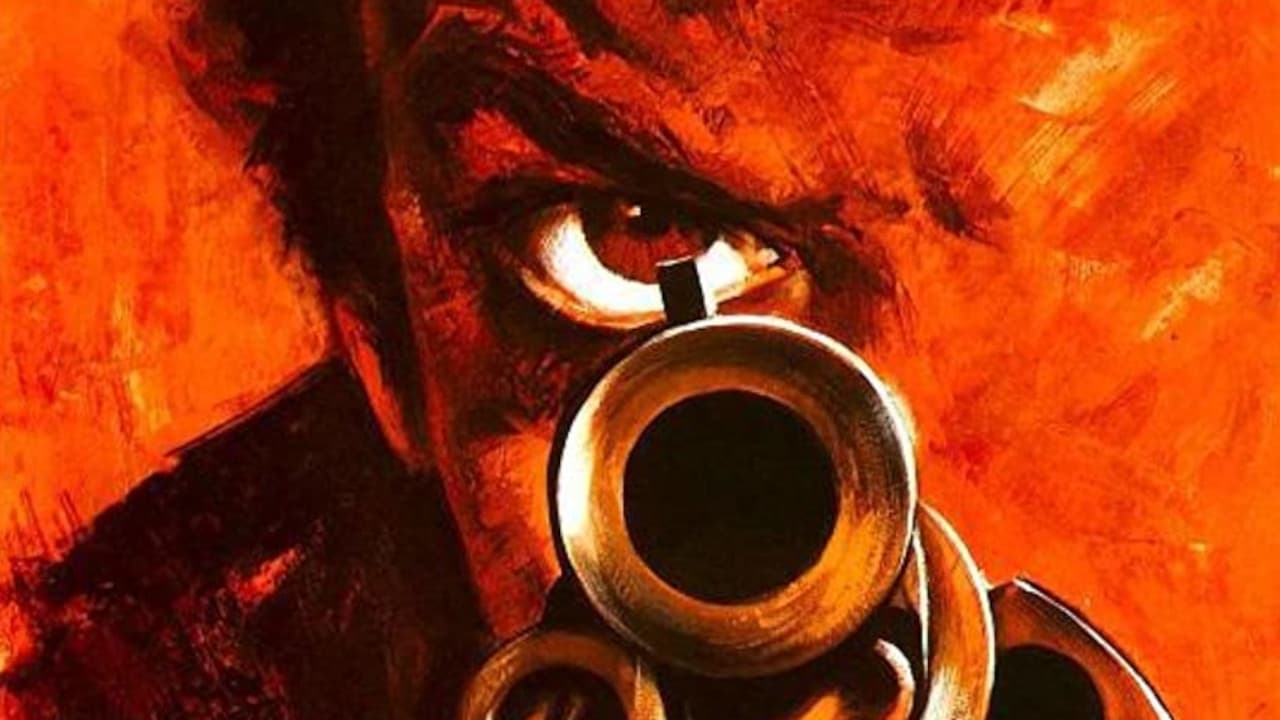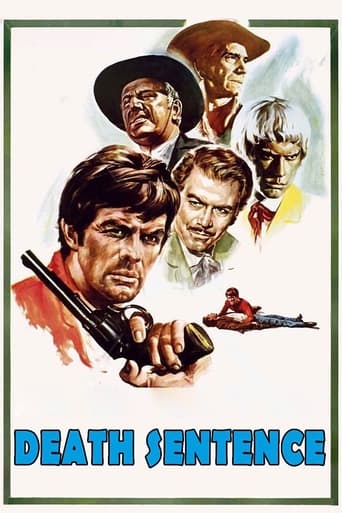ada
the leading man is my tpye
Mjeteconer
Just perfect...
Btexxamar
I like Black Panther, but I didn't like this movie.
FuzzyTagz
If the ambition is to provide two hours of instantly forgettable, popcorn-munching escapism, it succeeds.
Leofwine_draca
DEATH SENTENCE is a stylishly violent revenge western featuring a gunslinger who goes hunting for the men who bumped off his brother years before. The main character is called Django but this seems to be a tacked-on affectation. Robin Clarke's hero is rather bland, but the four actors who make up the bad guys are well cast in their roles: Tomas Milian, typically kooky as an eccentric Albino; Enrico Maria Salerno as a card player; Hollywood guest star Richard Conte as a tired rancher; and finally Adolfo Celi as a crooked priest. The film moves along at a fair old clip with one manhunt and showdown after another, and as such the running time feels like it flies past.
morrison-dylan-fan
For a poll being held on ICM for the best movies of 1968 I started to gather Spaghetti Westerns to watch from the year. Whilst gathering up the most famous Spaghetti's from the year,I stumbled on a lesser known one that I've heard about for years,which led to me joining Django for four adventures.The plot:Learning that his brother has been killed by four outlaws,Django vows to get his revenge.Story 1:Appearing from out of nowhere in a desert,Django sets his sight on retired farmer/thief Diaz. Thinking he can lock Django in a death pen on his farm,Diaz soon finds that the sands of time have other plans.Story 2:Traveling to a remote town,Django finds the locals surrounding the table of his next target Montero,who is a ruthless gambler that never loses a hand. Joining the table,Django pulls out the death card.Story 3:Going to a town ruled by outlaws,Django gets lassoed by the fire and brimstone of church leader Friar Baldwin. Aware of who he is,Baldwin gets set to perform last rites on Django,but soon meets his end of days.Story 4:Finding out that a town has lost its bank after outlaw (and one of his brothers killers) O'Hara has left the place bare,Django decides to open up a bank. Bringing bags of money into the bank,Django sees the face of O'Hara reflecting in the gold.View on the film:Originally written as a non-Western Giallo four part TV series,the screenplay by writer/director Mario Lanfranchi smoothly converts the eps to a Western setting,with a 20-30 minute run time for each "ep" allowing a clean sketch of each encounter to be drawn,and for the peculiar elements to grow. Coming from a stage background, Lanfranchi makes the extended dialogue exchanges drip with dread,as the vagueness which Django keeps his background in,gives this avenging outlaw an otherworldly gloss.Introducing Django like a mirage in the desert, director Lanfranchi & cinematographer Antonio Secchi cast an entrancing supernatural Horror atmosphere, where eclipses of the sun are scattered across the screen and stylish tracking shots round the gambling table move with Django's dance of death. Backed by an unsettling score from Gianni Ferrio, Lanfranchi brilliantly sends Django into a surrealist nightmare. Spilling from the peculiar actions of Django that includes drinking milk by the pint instead of booze, Lanfranchi shakes the screen in waves of startling colours, via a deeply unsettling ghostly mood where over saturated colours follow Django's bullets,and lead to a thunderous final battle in a Gothic Horror church.Although he fell out with Lanfranchi. (who is a fantastic "character" on the bonus interview) over the director being "Too intellectual" Tomas Milian gives an absolutely barking mad performance as O'Hara,who Milian sends into a quivering mess at the mere sight of a hot blonde or Django having a fistful of gold. Becoming agitated on set after finding out that Lanfranchi had sent his girlfriend Ali MacGraw back to the US due to her endless spats with his lead, Robin Clarke gives a simmering performance as Django,via the stark calm Django shows when first meeting his next victim,being shot down by Clarke with a calculating fury,in these four tales of Django.
Perception_de_Ambiguity
"Better luck next time except there won't be a next time for you." Those are the very last words of the lyrics of the song that close the movie. And it's very descriptive of the movie. It doesn't even care to be thoughtful enough for an individual SEQUENCE taken for itself to be coherent or make sense. It obviously just strings together cool elements that end up being less than the sum of their parts yet you still somehow get the idea and with the right attitude you should get quite a lot of enjoyment out of it. The film is mostly set-pieces without them ever really being set up. The situations are always about life or death and rules are being made up as they go along..The movie starts with two men walking through the desert. One guy has two guns and no water. The guy in a safe distance behind him following him has water but no guns. Cool setup, huh? Yeah, except that it doesn't make an ounce of sense. Why would the guy with the guns run away deeper into the desert from the guy with the water? Wouldn't it make more sense the other way around? Through "Spaghetti Western Flashbacks" (courtesy of Quentin Tarantino) we learn that the guy with the guns, together with three other guys, killed the waterboy's brother and he wants revenge, which is what holds the movie together. Waterboy's revenge against four men who he is finishing off one by one in separate episodes is all there is to the plot. They are all killed in funny ways but let me just tell you about how this first "episode" ends.At night the two men take a break and they make a nap in the cozy desert sand (the duo-gun man rests next to a cross that sticks out of the sand in the middle of the desert) while waterboy uses the time to build a fake well out of stones that lie around. You see, earlier that day waterboy yelled to duo-gun man: "Hey, behind that dune over there is a well. Look, fresh water. Yum! (drinking the same old water he's been carrying around all along)" So the next morning (waterboy wasn't anywhere in sight) duo-gun man checks behind that dune and lo and behold, a well! He robs to it, looks into it and...all he sees is more sand. That's waterboy's cue to show up and shoot him dead. Waterboy pushes the body into the stone circle. His final resting place.It says a lot if I have to say that out of all the Spaghetti Westerns I've seen this is the most incoherent one. I can't even say that it is full of plot holes because it is LIKE a surreal piece, which per definition can't have plot holes. Yet it never really emits a surreal vibe. The film is well-shot with a lot of nice touches from start to finish in the shape of camera movement and composition, it looks more professionally made than most SWs, the visuals alone make it worth seeing for genre fans. The music is a lot of cool fun, it isn't very melodic and most of the time it's rather minimal, for example single pluckings of guitar strings which is pretty much my type of SW score.
MARIO GAUCI
Like THE PRICE OF POWER (1969), which I watched a couple of years back, I've found this to be a hidden Spaghetti Western gem of which I was completely unaware until just a few days prior to purchasing on R2 DVD! Though, ultimately, not quite as weird as DJANGO, KILL…IF YOU LIVE, SHOOT! (1967), as arty as MATALO! (1970), or as extreme as CUT-THROATS NINE (1972) – which seemed to be the case judging by the few online reviews that I came across in the interim – the film is certainly one of the most unusually-styled outings in this most prolific of "Euro-Cult" genres. With its frequent use of ellipses (notably a shock cut to the mangled body of a young woman) and even audaciously moving away from crucial moments (for instance, in the course of a duel), the choice I made to blind-buy DEATH SENTENCE proved to be entirely justified.The revenge plot is actually quite typical, being particularly reminiscent of DEATH RIDES A HORSE (1967): even the curiously milksop hero (played by the anonymous Robin Clarke and, thus, making for a good contrast with his famous adversaries) looks more than a bit like John Philip Law from that film! Given its episodic structure, the formidable quartet of villains are introduced one by one: Richard Conte (the most sympathetic of the lot as an aging farmer aspiring for stability – even if it's coming via the proceeds from a robbery which ends in cold-blooded murder!), Enrico Maria Salerno (as a compulsive gambler who likes to humiliate his opponents – but, obviously, finds his match in Clarke), Adolfo Celi (whose unscrupulous gang boss-cum-fanatical preacher may well have influenced Samuel L. Jackson's character in Quentin Tarantino's PULP FICTION (1994) – incidentally, he's ingeniously dispatched by way of an ostensibly empty gun which actually contains an extracted bullet that had previously been lodged in Clarke's own thigh!) and Tomas Milian (an especially memorable role for him as an epileptic albino with a taste for anything golden, be it money or women – his inherently campy qualities here anticipated some of the star's outlandish later roles in various poliziotteschi!). Though not figuring prominently in the narrative, the three attractive female presences of the film are nonetheless given reasonable characterizations – enough to provide the whole with some much-needed humanity, serving as respite from the general bleakness and dominant feeling of machismo. Characteristic of the Spaghetti Western genre, one of the undeniable assets of DEATH SENTENCE lies in the excellent score by "Euro-Cult" stalwart Gianni Ferrio (highlighted by an especially haunting theme tune).Mario Lanfranchi was a distinguished stage director who worked only fitfully for the cinema; an opera enthusiast, he brought a number of these to the screen – but, apart from the film under review, he also made such genre efforts as the erotic drama IL BACIO (1974) and the poliziottesco MERCILESS MAN (1977). In the amusingly theatrical interview included on the Koch Media DVD, he comes across as something of a self-promoter but remains nonetheless a most affable host throughout (and remarkably fluent in English). He mentions a number of interesting anecdotes pertaining to the shooting of the film: the fact that Milian bore him a grudge because he considered Lanfranchi too intellectual; Salerno would only work for a specified number of hours each day and often left the set in mid-sequence!; Lanfranchi felt that the presence on set of Clarke's current girlfriend (Ali MacGraw) was proving an intrusion, so he had her fly back home to New York unbeknownst to Clarke – the actor's subsequent fury at this affront came through in his performance, thus effectively achieving just what the director wanted for the character!; the writer/director also hilariously mentions a surreal incident involving a cow that took place at composer Ferrio's house, and which seems to come straight out of Luis Bunuel's L'AGE D'OR (1930)! After viewing this delightful and informative reminiscence (lasting nearly half-an-hour), I look forward now to listening to Lanfranchi's Audio Commentary.One final note: the DVD, unfortunately, was plagued with a couple of playback glitches – freezing at the disc's layer change and occasional audio dropouts during the interview; these were quite glaring on my Pioneer model but, thankfully, proved less conspicuous when I tried the DVD on my other (cheaper) brand of player!

